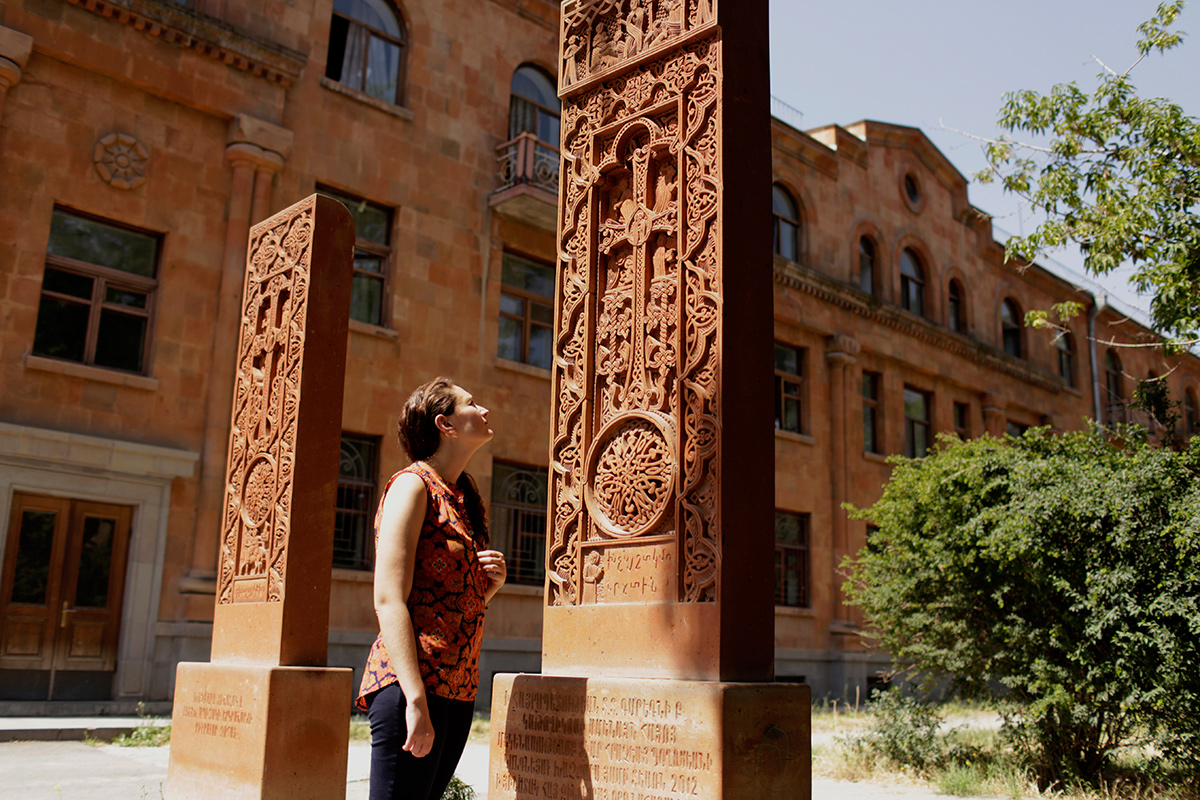Discovering Ancient Armenia with Diasporan Eyes and Ears

Birthright Armenia aims to strengthen ties between the homeland and Diasporan youth by affording them an opportunity to be a part of Armenia’s daily life and to contribute to Armenia’s development through work, study, and volunteer experiences, while developing lifelong personal ties and a renewed sense of Armenian identity. Julia Hintlian submitted this article about her experience with the program.
Twice a week for the last year, I had dinner in Winchester, Massachusetts, with my ninety-six-year-old Armenian grandmother, Tarvis. We would sit at her kitchen table, usually eating Chinese food, and eventually, we would begin to hum a mysterious Armenian folksong with a name my grandmother could not remember. The lyrics haunted me:
Ov gu dan mez hatz ou chur, barevit mernim
Arevit mernim yar jan, arevit mernim yar jan, sirelem garnem
Who gives us bread and water,
I would die for your greeting.
I would die for your sun, I would die for your sun.
My dear, I loved you, and I will marry you.
Though I searched online and recruited the help of my Armenian teacher at school, I could not find the name of this song.
However, my luck changed when I arrived in Yerevan four weeks ago to participate in Birthright Armenia, an internship program that helps young Diasporan Armenians connect with the modern Republic of Armenia. I was placed with a homestay family, and, on my second night, I began to sing:
Arevit mernim yar jan, arevit mernim yar jan.
Suddenly, my new host sister, Armine, smiled.
“I love that song!” she exclaimed. “It is called ‘Es Puchur Yars Puchur’!”
At that moment, Armine and I built a bridge: a bond between the ancient, mythical Armenia that my ancestors carried to America a century ago and the Caucasian country that sings in the present.

This idea of links between past and present, ancient and modern, describes my engagement with Armenia more broadly. I just completed my master of theological studies at Harvard University with a focus on Silk Road religions. This fall, I will continue my doctoral studies at Harvard with a concentration in the history of Christianity. My research specifically concerns the influences of Zoroastrian and Manichaean thinking on ancient Syriac and Armenian Christianity. If any of these terms seem foreign, don’t worry—my interests are quite niche!
As a student and an aspiring scholar, I am continually seeking new ways to make my work relevant to the modern world. This summer, Birthright Armenia gave me several opportunities to make this goal a reality.
I recently started a project with a young seminarian from Etchmiadzin, the seat of the Armenian Apostolic Church, to film videos teaching Classical Armenian (grapar) grammar and vocabulary. While Classical Armenian is quite different from either of the extant modern Armenian dialects (Eastern and Western), it was the language spoken by our people in ancient times, and it remains the language of the Church and the Divine Liturgy. It is useful for Armenians across the world who attend Apostolic Church to know Classical Armenian so that they can understand the theological and spiritual messaging of their religious communities. We are hoping to make our videos available to a virtual audience by the end of the summer.
I am also working on another project to help Thomas Samuelian, the famous Armenian American scholar and lawyer, translate The Travails of the Ninth Century, a historical novel written in Western Armenian in 1877, into English. Written by Armenian author Tserents, the book details the ancient Arab invasions into Armenia and tells a romanticized version of how the Armenian nakharars (lords) bravely fought to protect their homeland. Many modern Armenians bear the pain their ancestors suffered in the late nineteenth and early twentieth centuries; Tserents harkens back to even earlier challenges. Our translation of this text helps connect Armenian struggles for survival from ancient times through the present day.

Being an Armenian American in Armenia forces me to face the question: what is Armenia, anyway?
Is it the people who raised me and the way my grandmother clasps my hand when we sing together? Is it the art, architecture, literature, history, and language that I study? Is it Etchmiadzin and the priests who work in tandem across the world to keep our spirituality alive? Is it the ginger tea that Armine and I share on unbearably hot summer nights? Is it the old friends from Boston I encounter in the streets of Yerevan, or the new network that I am building through Birthright Armenia?
Ultimately, the threads of our ancient culture, religion, and language are woven through our responsibilities to family, our relationships with friends, and our participation in the communal discourse. It is this loyalty to active citizenship that has kept us together for the last 3,000 years, and I know it will link us together into the future.
Julia Hintlian is beginning her doctoral study in the history of Christianity at Harvard University. She is working on merging her discoveries in Armenia with her Armenian American life.
Birthright Armenia is sponsoring discussions and performances on the Hyurasenyak and Aygi Stage at the 2018 Folklife Festival.

